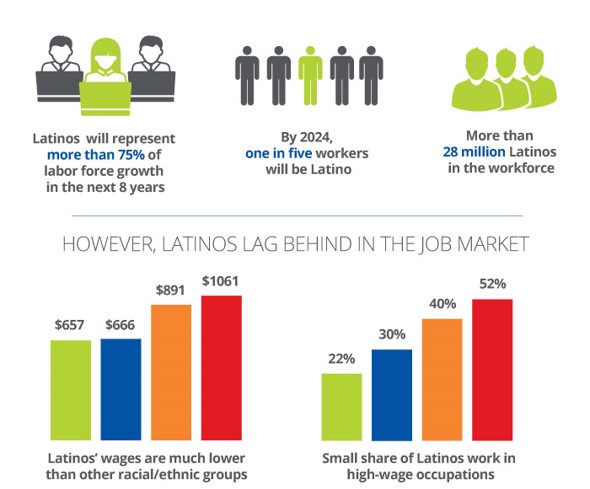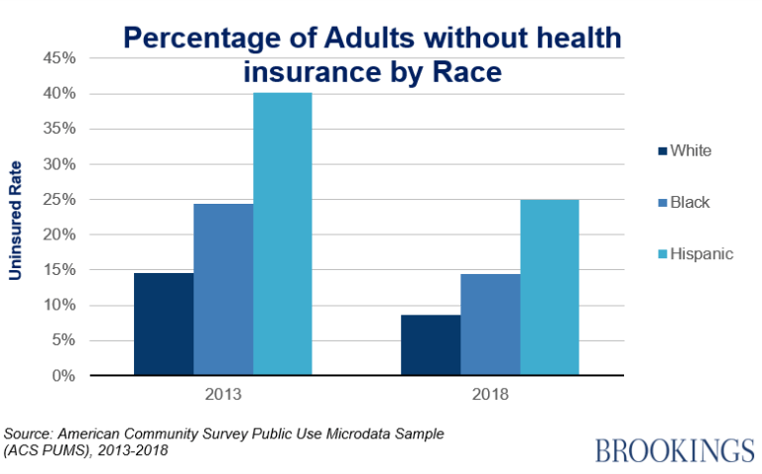
The approximately 606,000 Maryland Latinos come from every walk of life, tend to be younger than the rest of the population, and represent a mix of and represent a mix of second and third-generation immigrants, as well as recent immigrants. A significant portion of the immigrant community comes from Central America and the Caribbean, and a growing number originate from Mexico. Many Maryland Latinos are employed as guest workers in essential industries like agriculture, seafood, and meatpacking.
The data we do have reveals widespread disparities and inequities faced by Maryland’s Latino and immigrant communities.
DATA:
Latinos in Maryland
Workforce and the Economy
- In April 2020, approximately 61 percent of Hispanics and 44 percent of Black Americans in the US reported that they or someone in their household experienced job or wage loss because of COVID-19.
- In Maryland, in October 2020 compared to whites, Latinx rates of unemployment stand at two to one during the pandemic, slightly higher for African Americans.
- Nationally, 72 percent of Latino and 55 percent of Native American respondents say their households are facing serious financial problems, compared with 36% of whites.

Higher Education

- Statewide, 28 percent of Latino adults have an associate degree or higher, compared to 53 percent of white non-Hispanic adults.
- Latino students graduate from two-year institutions at a rate five percentage points lower than White students—23 percent and 28 percent, respectively.
- Although Latino students have high graduation rates at four-year institutions, Latinos graduate at a rate seven percentage points lower than their White peers—69 percent and 76 percent, respectively.
Health Care
- One in two Latinx are expected to become diabetic over their lifetime.
- Diabetes often brings mental health problems in its wake: one in five diabetics have depressive symptoms. But Latinos are also less likely to receive treatment for depression, anxiety, and other behavioral issues than their white counterparts.


COVID-19 Pandemic
Latinos have been impacted disproportionately by the Coronavirus Disease (COVID-19). In April 2020, approximately 61% of Hispanics and 44% of Black Americans reported that they or someone in their household experienced job or wage loss because of COVID-19. Black and Hispanic workers are overrepresented in industries that are affected by social distancing mandates and stay-at-home orders, such as restaurants, retail, and construction, where Latino men make up more than 25% of construction workers.
Due to the economic impact of the virus, families are experiencing difficulties paying their monthly bills. In May 2020, 44% of Hispanics indicated they could not pay some of their bills or could only make partial payments. The pandemic has not only caused a health crisis but has also created an economic emergency.
Community leaders and institutions such as local food banks report that families are suffering from receiving little to no assistance. Moreover, assistance that is available from local organizations and nonprofits is operating at full capacity and under severe stress.
Undocumented families are impacted at a greater rate than the general population. Many undocumented workers have been laid off, and others are classified as essential employees. Grocery store workers, agricultural laborers, meat processing plant employees, healthcare staff, and janitorial workers have risked their health and the health of their families during these uncertain times. Often, these brave workers are not equipped with adequate protective gear, yet they persevere, providing services the public needs.
Once infected, our immigrants, many of which are essential workers, are placed in an untenable situation. They lack health insurance and consequently many hesitate to seek appropriate care or decide to withgo it entirely. They also tend to live in close quarters, making effective quarantining impossible. In addition, the fear instilled by the Federal Public Charge rule and limited healthcare access within communities of color and immigrants discourages community members from being tested and treated for COVID-19.
The health disparities can be identified clearly. In Maryland, the largest number of COVID-19 cases are found in zip codes with high populations of Black and Latino residents, many of who are immigrants and/or undocumented.
Our undocumented immigrant community keeps the economy functioning, yet they have been excluded from federal financial relief and are ineligible for unemployment insurance. Many undocumented workers pay their taxes using an Individual Taxpayer Identification Number (ITIN). The IRS estimated that ITIN tax filers pay an estimated $9 billion in payroll taxes annually. In Maryland, undocumented residents contribute roughly $139 million in state, local, and sales taxes. As the economy collapses, the existing racial and ethnic inequalities will increase in severity.
